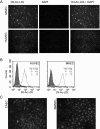Isolation and in vitro culture of vascular endothelial cells from mice
- PMID: 25605995
- PMCID: PMC4297760
- DOI: 10.4196/kjpp.2015.19.1.35
Isolation and in vitro culture of vascular endothelial cells from mice
Abstract
In cardiovascular disorders, understanding of endothelial cell (EC) function is essential to elucidate the disease mechanism. Although the mouse model has many advantages for in vivo and in vitro research, efficient procedures for the isolation and propagation of primary mouse EC have been problematic. We describe a high yield process for isolation and in vitro culture of primary EC from mouse arteries (aorta, braches of superior mesenteric artery, and cerebral arteries from the circle of Willis). Mouse arteries were carefully dissected without damage under a light microscope, and small pieces of the vessels were transferred on/in a Matrigel matrix enriched with endothelial growth supplement. Primary cells that proliferated in Matrigel were propagated in advanced DMEM with fetal calf serum or platelet-derived serum, EC growth supplement, and heparin. To improve the purity of the cell culture, we applied shearing stress and anti-fibroblast antibody. EC were characterized by a monolayer cobble stone appearance, positive staining with acetylated low density lipoprotein labeled with 1,1'-dioctadecyl-3,3,3',3'-tetramethyl-indocarbocyanine perchlorate, RT-PCR using primers for von-Willebrand factor, and determination of the protein level endothelial nitric oxide synthase. Our simple, efficient method would facilitate in vitro functional investigations of EC from mouse vessels.
Keywords: Endothelial cells; In vitro culture; Mouse vessels.
Figures






References
-
- Carmeliet P. Angiogenesis in health and disease. Nat Med. 2003;9:653–660. - PubMed
-
- Choi S, Kim JA, Na HY, Kim JE, Park S, Han KH, Kim YJ, Suh SH. NADPH oxidase 2-derived superoxide downregulates endothelial KCa3.1 in preeclampsia. Free Radic Biol Med. 2013;57:10–21. - PubMed
-
- Choi S, Kim JA, Na HY, Cho SE, Park S, Jung SC, Suh SH. Globotriaosylceramide induces lysosomal degradation of endothelial KCa3.1 in fabry disease. Arterioscler Thromb Vasc Biol. 2014;34:81–89. - PubMed
-
- Park S, Kim JA, Joo KY, Choi S, Choi EN, Shin JA, Han KH, Jung SC, Suh SH. Globotriaosylceramide leads to K(Ca)3.1 channel dysfunction: a new insight into endothelial dysfunction in Fabry disease. Cardiovasc Res. 2011;89:290–299. - PubMed
LinkOut - more resources
Full Text Sources
Other Literature Sources

